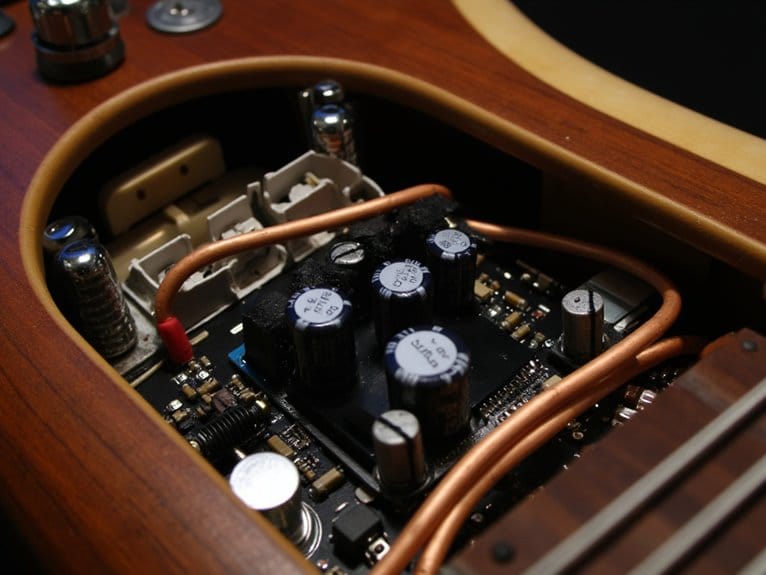FM Synthesis: Complex Tones From Simple Operators
You’ll discover that FM synthesis creates complex tones using simple operators-oscillators that either carry the audible signal or modulate other frequencies. When you configure one operator to modulate another, you’re generating new harmonics and sidebands that transform basic sine waves into rich, evolving textures. The modulation index controls brightness and spectral complexity, while frequency ratios determine whether you’ll achieve harmonic musical tones or inharmonic metallic sounds, and there’s considerably more depth to explore in this synthesis method.
We are supported by our audience. When you purchase through links on our site, we may earn an affiliate commission, at no extra cost for you. Learn more.
Notable Insights
- FM synthesis uses operators containing oscillators and amplifiers that modulate each other to generate complex harmonics and sidebands.
- Integer frequency ratios create harmonic musical tones, while non-integer ratios produce inharmonic metallic and percussive textures.
- Modulation index controls spectral complexity and brightness, allowing simple operators to create dramatically different sound characters.
- Layered modulation chains and sophisticated operator configurations transform basic mathematical relationships into expressive musical timbres.
- Digital implementation provides precise frequency control and repeatable programming, enabling complex algorithmic structures from simple building blocks.
The Building Blocks: Operators and Modulation Fundamentals
While I’ve spent countless hours tweaking synthesizer parameters, I’ll admit that FM synthesis initially seemed like digital wizardry until I understood its elegant foundation: the operator.
FM synthesis transforms from mysterious digital sorcery into elegant simplicity once you grasp the fundamental building block: the operator.
You’ll find that each operator structure contains an oscillator, amplifier, and routing system, functioning as either a modulator or carrier depending on your configuration.
When you assign one operator to modulate another’s frequency at audio rates, you’re not creating vibrato-you’re generating entirely new harmonics and sidebands that weren’t present in the original signals.
The modulation index, which represents the ratio between your modulator’s amplitude and carrier frequency, becomes your primary tool for controlling spectral complexity, brightness, and the overall character of your synthesized sound.
Crafting Harmonic and Inharmonic Textures Through Frequency Ratios
Once you’ve grasped how operators modulate each other, the mathematical relationship between your carrier and modulator frequencies becomes the sculptor’s chisel for your sonic palette.
Integer ratios like 1:1 or 1:2 produce harmonic textures with clear, musical pitch-perfect for traditional melodic content.
However, when you venture into non-integer territory with ratios like 1:1.5 or 1:3, you’ll reveal inharmonic effects that create metallic, bell-like timbres essential for percussive synthesis.
I’ve found that ratios above 1:3 generate increasingly complex inharmonic content, producing those distinctive clangorous sounds you hear in electronic percussion.
Digital Revolution: From Analog Instability to Precise Control
The semiconductor revolution of the early 1980s transformed FM synthesis from an unstable analog curiosity into the precise digital powerhouse that would reshape electronic music forever.
You’re witnessing digital evolution at its finest, where John Chowning’s Stanford research finally met practical implementation through Yamaha’s commercial genius.
This sound innovation breakthrough delivered four game-changing advantages:
- Precise frequency control – Digital operators maintained exact ratios without analog drift
- Repeatable programming – Settings stayed consistent across performances and recordings
- Complex algorithmic structures – Multiple operators could interact with mathematical precision
- Stable tuning systems – No more temperature-sensitive oscillators ruining your carefully crafted patches
While I’ll admit the DX7’s programming interface wasn’t exactly user-friendly, its impact proved undeniable, establishing digital FM as the foundation for modern synthesis architecture.
Practical Techniques for Modern Sound Design Applications
Beyond the historical significance of FM’s digital revolution, today’s sound designers have access to sophisticated operator configurations that transform basic mathematical relationships into rich, evolving sounds capable of rivaling any synthesizer architecture. These advancements have opened up new possibilities for sound exploration, allowing for intricate modulation and layering that can breathe life into even the simplest of waveforms. Coupled with wavetable synthesis techniques explained in various tutorials, designers can create timbres that are not only unique but also highly adaptable to different musical contexts. As a result, the landscape of electronic music continues to evolve, with innovative soundscapes becoming a hallmark of modern production.
You’ll find that layered modulation chains, where multiple oscillators serve as both carriers and modulators, create complex timbres that morph and breathe with musical expression.
I’ve discovered that combining different waveforms-sine waves for clarity, sawtooth for harmonic richness, and noise for texture-produces remarkable sonic variety when processed through selective filtering.
Adding LFO modulation to FM amounts and filter cutoffs introduces movement that keeps your patches from sounding static, while strategic use of reverb and delay transforms mathematical precision into immersive, three-dimensional soundscapes that captivate listeners.
Modern FM synthesizers like the Korg Volca FM2 deliver authentic DX7-style synthesis with six operators, making professional FM sound design accessible to musicians at every budget level. The Hydrasynth Desktop takes this further with its 219 single cycle waveforms across three oscillators, expanding the palette beyond traditional FM synthesis into hybrid territory. These innovative instruments are perfect for both beginners and seasoned professionals looking to delve into sound design without breaking the bank. When searching for the best budget synthesizers to explore, these models stand out for their versatility and depth, allowing users to experiment and create unique sounds. As technology continues to evolve, having access to such powerful tools within an affordable range opens up endless creative possibilities.
On a final note
You’ve now got the foundation to access FM synthesis‘s incredible potential, from those basic operator relationships I’ve covered to the complex modulation matrices that’ll transform your sound design workflow. Whether you’re crafting metallic percussion hits or evolving pad textures, remember that subtle ratio adjustments often yield the most musical results. Don’t overthink it-start with simple two-operator patches, then gradually build complexity as your ears develop those essential FM instincts.







